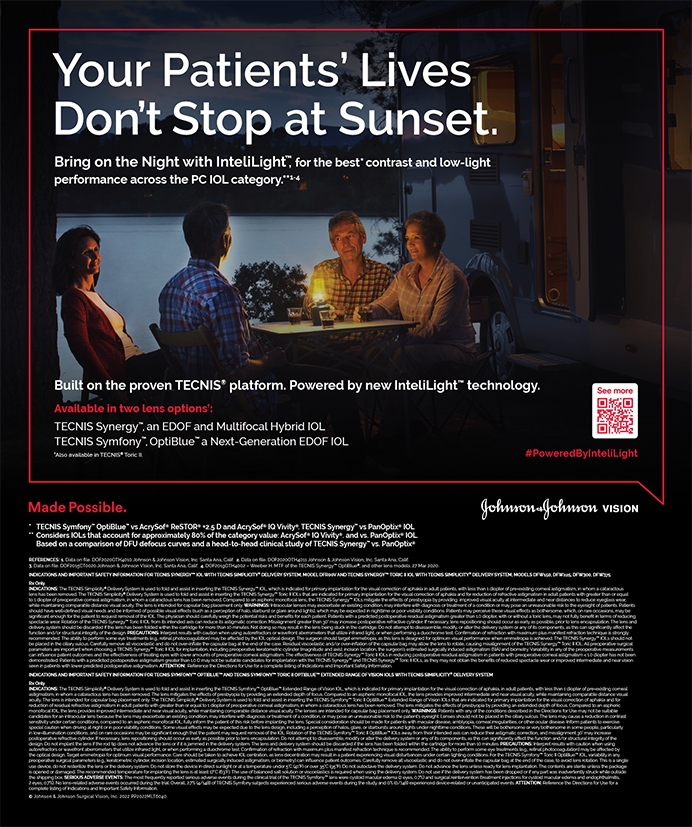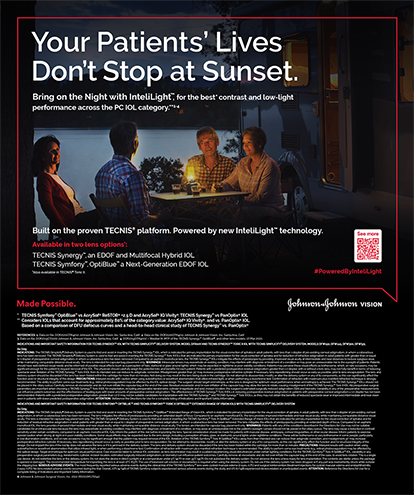I use the no-stitch incision technique, which I learned from Walter Stark, MD, in aphakic patients who require a lens replacement procedure. Of the various methods that have been described to insert secondary implants, the most common usually employ a nonfoldable anterior chamber PMMA lens that requires a larger incision (approximately 5.5 mm) and sutures to close it. That type of technique may be problematic for patients who have chronic iritis, glaucoma, or abnormal iris architecture. Another option involves a posterior chamber lens sutured through the sclera. This technique also uses nonfoldable PMMA implants with larger optics, and it requires passing sutures through the sclera and tying them on its surface. The sutures can erode over time, in which case they must be removed and the lens loses its support. There is also a higher risk of retinal complications related to passing sutures through the sclera.
The no-stitch incision technique uses a foldable acrylic lens inserted through a 3.2- to 3.5-mm clear corneal, sutureless incision. I suture the haptics to the iris and position the lens in the posterior chamber. In this way, no sutures pass through the eye, and the lens does not sit in the anterior chamber angle, so it is safer for glaucoma patients. I feel this technique is simpler than using scleral sutured lenses and better than using anterior chamber lenses because it does not invade the anterior chamber angle, does not need to be sized, and is safe to use in glaucoma and iritis patients. It also involves a small sutureless incision, and the surgeon can incorporate astigmatic and other incisions if he wishes.
THE TECHNIQUE
I begin with an undilated pupil. I make a clear corneal incision temporally and then three other paracentesis incisions (one directly nasal, one directly superiorly, and one inferiorly). For example, in the right eye, I locate the temporal incision at the 9-o'clock position and the paracenteses at the 12-o'clock, 3-o'clock, and 6-o'clock positions. Next, I remove any free vitreous in the anterior chamber using a bimanual vitrectomy technique, and I fill the anterior chamber with Viscoat viscoelastic (Alcon Laboratories, Inc., Fort Worth, TX). With a folding forceps, I bend the implant into a mustache fold, and then I insert a cyclodialysis spatula through the nasal paracentecis incision to steady the implantation of the IOL. I insert the IOL through the temporal clear corneal incision. The haptics are positioned downward through the undilated pupil. As the optic opens, I place the cyclodialysis spatula posterior to the optic, supporting it as it unfolds. Once opened, the optic will be trapped in the anterior chamber by the pupil margin, and the haptics will be located in the posterior chamber behind the pupil.
Once the lens is in position, I again place the cyclodialysis spatula under the optic of the lens and lift up so that the haptics tent the iris upward. I then pass the suture needle through the clear cornea, across the anterior chamber, into the iris through the anterior chamber side, around the back of the haptic that is in the posterior chamber, out the other side of the iris and back into the anterior chamber, and then out again through the clear cornea on the opposite side of the eye (Figure 1). Then, I cut the needle off.
Through the inferior paracentesis incision (for the inferior haptic), I use a Lester lens hook to grab the free end of the suture on either side of the haptics and pull it out through the other side of the paracentesis incision (this pass should be made in the midperipheral to peripheral iris). I tie down that suture, securing the haptic of the lens to the iris. After cutting the knot, I repeat the same procedure for the other haptic of the lens. When finished, I have sutured the haptics to the iris superiorly and inferiorly. Next, I use the spatula to depress the optic of the implant through the pupil. Finally, I perform a vitrectomy to clean the anterior chamber, remove the Viscoat, and refill the eye.
POSTOPERATIVE TREATMENT
I usually use Acular PF topical NSAID (Allergan, Inc., Irvine, CA) in addition to Econopred ophthalmic drops (Alcon Laboratories, Inc.) because of the involved vitreous and iris manipulation. This maneuvering may carry an increased risk of cystoid macular edema, and I therefore routinely add this medication postoperatively for all secondary lens procedures and any procedure that involves significant iris manipulation.
The patient's pupil may be dilated normally during an exam and should work normally following the surgery. The procedure may be performed under topical anesthesia with intracameral 1% lidocaine. Also, I often give these patients an injection of 2% lidocaine in a peribulbar fashion to make them more comfortable postoperatively, because the iris manipulation and the vitreous work can often cause a few hours of soreness in the eye. I follow the injection by patching the eye for a few hours.
Robert Arleo, MD, is in private practice at the Arleo Eye Institute in Ithaca, New York. He holds no financial interest in any product or technology mentioned herein. Dr. Arleo may be reached at (607) 257-5599; Rarleo@aol.com.

